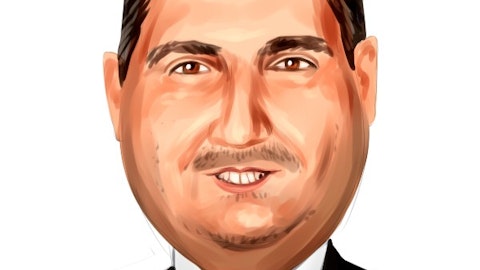I mean I think we’re at in both businesses is that at the moment, even though revenues are recovering, particularly on the behavioral side, salary expense or wage expenses still outpacing the growth in revenues. I think we believe that by the second half of 2023, that begins to sort of stabilize and we start to sort of get to a more normalized historical pattern of revenue growth exceeding salary growth. But in the first half of the year, that’s not the case. And again, I think that’s probably the main driver of the margin pressure next year.
Operator: Thank you. Our next question comes from the line of Jason Cassorla with Citi. Jason?
Jason Cassorla: Great. Thanks for taking my question. I just wanted to ask about the move to wind down in patient operations at your Desert Springs Hospital. Maybe just can you unpack that a bit more in the decision there? What the EBITDA lift could be on the go forward? And then anything else to note from a competitive perspective as we think about your Las Vegas market broadly? Thanks.
Marc Miller: Yes, sure. I can answer that, for you. So, we obviously €“ that’s a very important market for us. We’ve been looking at the whole market €“ the market as a whole for many years. We continue to try to build where we can at current properties as well as some of our de novo projects. We have a new project that’s going in that is really €“ we’re looking at it as a replacement hospital for Desert Springs. Originally, we had hoped to keep Desert Springs operating longer into the future and closer to our opening date, if not all the way up to our opening date for our new West Henderson Hospital. But the market dynamics caused us to have to accelerate the plan there. So what we’ve done basically is, we’re moving that hospital to a glorified emergency services facility and we’ll continue to run those services even after we have our new hospital in West Hendersonville, and we’re really transferring just about all of those employees to other valley system facilities.
So, we’re €“ it’s been misreported that we’re laying off a lot of employees. In fact, we’re really not. And like I said, just about every one of those employees is finding a home in another one of our hospitals, which has helped alleviate some of the staffing pressures that we’ve had. So that’s really the situation. I don’t know the timing on the numbers. West Henderson won’t be open for about another year and a half, I want to say middle to late 2024?
Steve Filton: Yes.
Operator: Our next question comes from the line of A.J. Rice with Credit Suisse. A.J.?
A.J. Rice: Hi everybody. Thanks. Maybe just two items. And when I think about your outlook, I think you mentioned that you’re assuming an uptick in physician subsidy expense. I wondered what’s happening there? I know in the back half of the year, your other operating expense in 2022 seemed to step up. Are you just assuming that continues? Or is there something else going on there and chances to mitigate? And then any update on your capital deployment thoughts? I know you probably got some share repurchase in the 2023 outlook. Can you just comment on that? And anything else that you’re thinking about from a capital standpoint?
Steve Filton: Sure, A.J. Yes, so physician subsidy expense, I think, has been kind of an emerging challenge for most of the acute hospital industry, I would say, for at least the back half of 2022, and I think most acknowledge it will continue into next year. So that’s €“ when we talk about that, we’re really talking about the generally, the contract service expense we pay to physicians who are providing services in our emergency rooms, anesthesiologists, radiologists, those are probably the major groups. And you’re right, we have seen some increase in those expenses this year. I think we continue to assume that 2023 will probably result in another 15% to 20% increase in those expenses and the magnitude of that is probably a $45 million, $50 million increase in costs.



